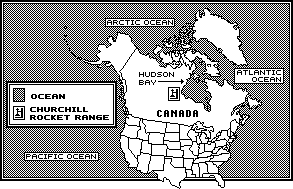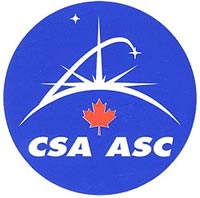 Canadian Space Agency operates the Churchill Rocket Research Range in the northeastern part of the country at Fort Churchill, Manitoba, on Hudson Bay. The Canadian and U.S. space agencies have launched small sounding rockets -- Nike-Orion and Black Brant -- from Churchill.
Canadian Space Agency operates the Churchill Rocket Research Range in the northeastern part of the country at Fort Churchill, Manitoba, on Hudson Bay. The Canadian and U.S. space agencies have launched small sounding rockets -- Nike-Orion and Black Brant -- from Churchill.
The Churchill region, close to the geographic center of the North American continent, is located on the seacoast edge of the Hudson Bay Lowland, the largest peatland in North America, between arctic tundra and boreal forest.
The area has a tremendous diversity of plants, birds, mammals and human cultures. As one of the oldest settlements in Canada and as the focus of many international scientific programs, the region has a long history of research in the life and earth sciences.
History. Canada's space activities began in the 1930s when scientists studied the upper atmosphere using ground-based instrumentation. After World War II, Canada expanded its atmospheric observations by building and using rockets and balloons.
Since the 1950s, Canada has been involved with space and high atmospheric research using sub-orbital launchers. That early work and tradition formed the foundation of the Canadian space program.
The Churchill Rocket Research range in Manitoba played an important role in the Canadian natural space and atmospheric research program. Launch activities at the Churchill site began in 1954 with a series of Nike/Ajax rockets and included the launch of five United States scientific rockets.
The Churchill Range was refurbished in 1957, known as the International Geophysical Year, and began launching sounding rockets to study the earth's near space environment and mid-auroral belt. During its period of operation, the facility was involved in the launch of over 3,500 rockets on a year round basis.
The opening of the Churchill Research Range in Manitoba, and the development by Bristol Aerospace in Winnipeg of the BlackBrandt series of rockets, allowed Canada to make major scientific contributions to the International Geophysical Year in 1957-1958.
Third in the World. With the launch of the Alouette I research satellite in 1962, Canada became the third country in the world to design and build its own satellite.
Alouette I was followed in 1965 by Alouette 11. That spacecraft was a scientific success and achieved a goal of equal significance-the successful transfer to Canadian industry of space technology developed by the federal government.
First in the World. With the launch of Anik-A 1 in 1972, Canada became the first country in the world to operate a commercial domestic communications satellite system.
The Churchill range has hosted more than 3,500 small rocket launches since the 1950s carrying experiments into the atmosphere.
Canadian-built 3,000-lb. Black Brant rockets have been launched from the National Research Council's Churchill Research Range at Fort Churchill, Manitoba, to study the aurora and atmosphere at altitudes of 40 to 130 miles.
Among today's well-known rockets that could be fired from the Churchill Research Range in Manitoba are the U.S. Delta, Athena, Taurus and Conestoga; the Chinese Long March; the Israeli Shavit; the Russian Kosmos and Start; and the Ukrainian Cyclone.
In adition to Churchill Research Range, Canada also has space observation posts at Lynn Lake in Manitoba, Fort Smith in the Nunavut Territory (Northwest Territories), and Stony Rapids, Saskatchewan. Canada also has space facilities at Chesterfield Inlet, Nunavut Territory.
Geomagnetic Fields. The Defence Research Northern Laboratory of the Canadian government's Defence Research Board started photographing geomagnetic field variations at Fort Churchill in 1957 to provide information for the Fort Churchill Rocket Program. The National Research Council of Canada took over operation of the Churchill Research Range, with its Geomagnetic Observatory, in 1965.
Funding for the Geomagnetic Observatory was provided by the Dominion Observatory, Department of Mines and Technical Surveys (now the Geological Survey of Canada, Natural Resources Canada). Title was transferred to the department in 1972.
 Canadian Space Agency. The Canadian Space Agency (CSA), formed in 1990, coordinates the Canadian Space Program. The CSA chairs the Interdepartmental Committee on Space (ICS), which is composed of federal departments and agencies with an interest in space. CSA has a Long-Term Space Plan (LTSP) for continuing the Canadian Space Program through the 21st century.
Canadian Space Agency. The Canadian Space Agency (CSA), formed in 1990, coordinates the Canadian Space Program. The CSA chairs the Interdepartmental Committee on Space (ICS), which is composed of federal departments and agencies with an interest in space. CSA has a Long-Term Space Plan (LTSP) for continuing the Canadian Space Program through the 21st century.
CSA built and operates the Mobile Servicing System (MSS) on the International Space Station and the radar satellite system (RADARSAT) previously launched to space. CSA co-ordinates Canada's continuing participation in the European Space Agency (ESA) with responsibility for ongoing international space science and technology projects.
CSA operates the David Florida Laboratory in Nepean, Ontario, a world-class facility for testing satellites and components prior to launch. The laboratory is made available to Canadian companies on a cost-recovery basis. CSA also funds space-related R&D programs in Canadian universities.
Communications. Canada's Department of Communications (DOC) played a pivotal role in the development of the Canadian space industry. It developed the International Satellites for ionospheric Studies (Alouette-lSIS) programs and the Communications Technology Satellite (CTS), also known as Hermes.
DOC was instrumental in the formation of Telesat Canada, which was acquired subsequently by Alouette Telecommunications Inc., a company formed by Spar Aerospace and Canadian telephone companies.
DOC's largest space activity was the Mobile Satellite Communications System (MSA1), which was launched previously.
Although Canada's space communications system resides in the private sector, DOC retains important expertise in space communications systems, electronics and applications in the department's Communications Research Centre (CRC) at Shirley's Bay in Nepean, Ontario.
Remote Sensing. The Canada Centre for Remote Sensing, established by Energy, Mines and Resources Canada in 1972, is the lead agency for remote sensing in Canada.
The RADARSAT, launched from Vandenberg Air Force Base in California, made Canada the third nation with its own remote sensing satellite. The others were France and the United States. From 500 miles altitude, RADARSAT used synthetic aperture radar (SAR) to see through clouds, dust, fog and nighttime to provide detailed photos of Earth.
|
SARSAT Saves 5,000 Lives
The Search and Rescue Satellite (SARSAT) tracking station operated at Churchill by the Canadian Mission Control Centre at Trenton, Ontario, is credited with having contributed to the saving of some 5,000 lives around the world over the years through support of the SARSAT system. Canada has three such SARSAT stations. |
Environment. Other departments with a role in space activities are Environment Canada (Atmospheric Environment Service) and Fisheries and Oceans Canada. Most provincial governments actively support the development of space companies located in their provinces.
Canada's decisions to orient itself toward communications and, later, remote sensing were not unique. Most industrialized nations regard the use of space for communications and surveillance as being of national strategic importance. However, the associated high costs, high risks and long waiting period for economic returns have deterred some private sector investment. As a result, governments are important and active participants in the development of a domestic space industry through policy and financial support-either directly, with research and development (R&D) contracts, or indirectly, by providing a national market.
Today, Canada routinely uses space technologies for telecommunications, weather forecasting, air navigation, upper atmosphere research, resource management, search and rescue, and mapping, to name but a few applications.
Spaceport Canada. A Canadian company is spending $300 million to build a facility known as SpacePort Canada. on Hudson Bay. It will be a commercial launch site entirely devoted to sending satellites into polar orbits.
Akjuit Aerospace Incorporated is developing SpacePort Canada on the site of the Churchill Research Range.
Capable of launching small commercial expendable launch vehicles, the spaceport will have three launch complexes supporting sounding rockets, small expendable launch vehicles, and medium expendable launch vehicles. The spaceport will be able to accommodate Boeing Delta, Chinese Long March, Israeli Shavit, Russian Kosmos and Ukrainian Cyclone rockets as well as smaller Athena, Taurus and Conestoga launchers made in the United States.
Skywalker. A returnable space vehicle known as Skywalker could be carried aloft from Churchill by a 747 aircraft taking off from a runway. The 747 would drop the small space flier and Skywalker would blast itself on to space. At the end of its flight, Skywalker would land at Gander, Newfoundland. In bad weather, it could land at Dartmouth, Nova Scotia. Skywalker also might land at the White Sands Military Complex in New Mexico, or it could make an emergency landing at any airport and returned to Churchill by ship or cargo plane.
Tundra Domes. The so-called Tundra Aurora Domes were built at Churchill for scientific observation of the Aurora Borealis. The facility is now privately owned and used for viewing of the northern lights by tourists.
Golf Balls. A familiar landmark at Churchill is known as the Twin Golf Balls. Constructed as part of the rocket range radar system, the building houses two sixteen foot diameter dish antennas. In 1977, the rocket range switched to a different tracking system and the building was closed. The Twin Golf Balls now are privately owned.
| Spaceports | Rockets | Search STO | STO Cover | Feedback | Questions | © 2003 Space Today Online |